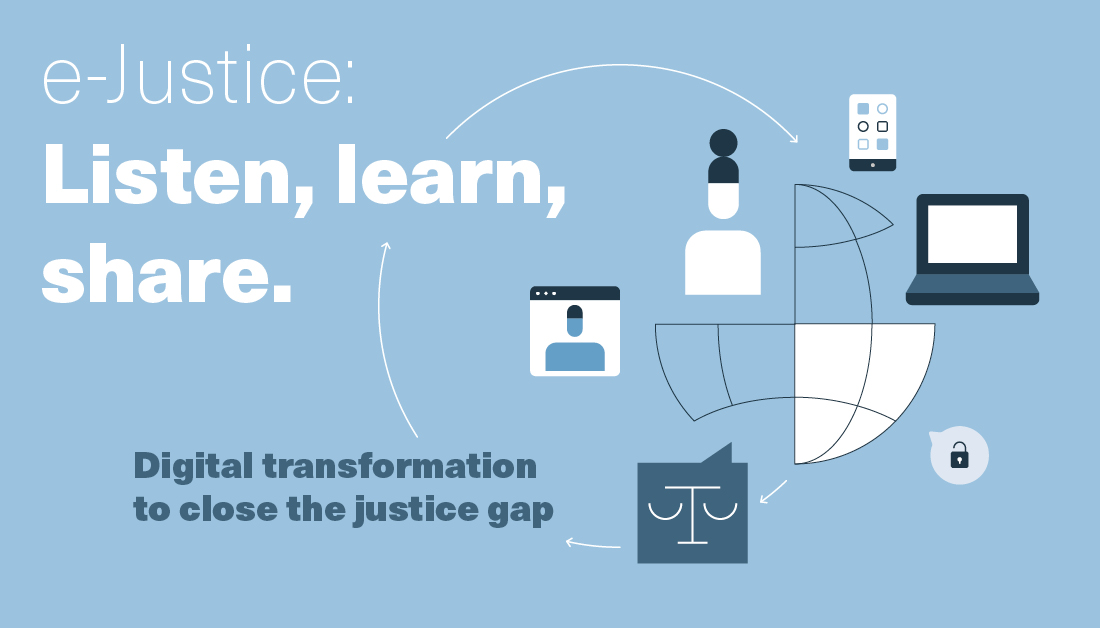E-justice: Listen, learn, share
June 1, 2022

We are facing a pandemic of injustice, fueled by major political crises, climate change, economic turbulence, and the consequences of the COVID-19 health crisis.
Back in 2020, when justice systems got paralyzed during lockdowns, technology was widely heralded as the solution to many issues of access to justice. Even before, it had been seen as an avenue to increase scrutiny of discrimination, corruption and abuse of power. Many justice system users are rightly calling for modernized systems, updated platforms for online filing and virtual courts. There is a new appetite for technology that is resilient to disruption.
While it is critical to promote e-justice as a deliberate, rigorous strategy for responding to the justice emergency, it should not be treated solely as an infrastructure update, but rather as a tool for system transformation. Embraced as a rights-protection strategy, e-justice has the potential to bring development approaches and the rule of law to the forefront, making all the e-justice projects people-centred, just as they should be.
With every digital step, governments, civil society, we as members of international community and digital champions, should ask ourselves: will this expand or improve access to justice? What privacy protections are there? Who owns the tech? Can everyone benefit?
To ensure that the potential of e-justice is fully embraced in the development and rights protection context, UNDP’s Global Programme for Strengthening the Rule of Law, Human Rights, Justice and Security for Sustainable Peace and Development has spotlighted this area as one of the priorities of its justice work in the programme’s phase IV (2022-2025).
To showcase best practices and lessons learnt, UNDP has surveyed e-justice projects globally. This massive undertaking materialized into a series of products: a research paper “E-Justice: Digital Transformation to Close the Justice Gap”, a toolkit and an interactive map. The toolkit presents seven specific tools for anyone working on e-justice to use in the design process to centre human rights and rule of law, and the map highlights over 200 projects allowing e-justice pioneers to connect globally and learn from each other.
This work has enabled us to identify strategies to shift to a more proactive and strategic approach to development-focused e-justice.
Listen
Really understanding how people experience injustice and rely on legal support is fundamental to transforming justice systems. For too long systems have focused on the experience of those working in the system, and not enough on those counting on it for economic security, basic safety and recognition of fundamental rights. Examples like Pakistan’s Human Rights Information Management System is capturing nuanced data, both locally and nationally, that is aligned with international obligations. This project builds a more complex understanding of human rights abuses and responses, informing the services offered to support people.
Learn
System transformation is neither fast nor smooth. Sustainable e-justice starts small, learning from mistakes and adapting to specific local needs before being scaled for a bigger impact. The Palestinian High Judicial Council partnered with UNDP to develop Mizan II, a case management system that focused first on access to and monitoring of court cases. The system has been expanded slowly, by scaling early lessons, to now integrate with family and financial enforcement, corrections, lawyers’ offices, public access terminals and corrections. More ministries are looking to build on the system because of its successful rights-respecting approach to data security, differentiated access and sustainable local IT expertise. Other countries in the region are looking to replicate this system and benefit from its sustained commitment to adapt and evolve over time.
Share
Working across institutions and sectors does not always come easily in the justice system where privacy and professional credentials can be barriers to transparency and data sharing. In Brazil, UNDP is working with judiciary on its Justice 4.0 initiative, linking a commitment to human rights protection across stages of the justice process. Focusing on people’s needs and experience, the system’s offerings range from artificial intelligence (AI) flagging cases of gender-based violence to the monitoring of human rights abuses in prisons and the integration of socio-economic support for people released from prisons.
These and many other cases are available in UNDP-created repository of e-justice projects. The next step is for development advocates to embrace e-justice as a strategic tool for transformation. In June 2022, UNDP launched its Justice Futures CoLab offering a space to explore, innovate and act together to address the justice challenges.
The justice emergency and the appetite for digital transformation is an opportunity for people-centred transformation. Well-designed e-justice focused first on people’s needs, with integrated systems for collecting aggregated data and monitoring international obligations, can harness this openness to change and result in more resilient justice systems designed to expand access to justice and advance rights protection.

 Locations
Locations
